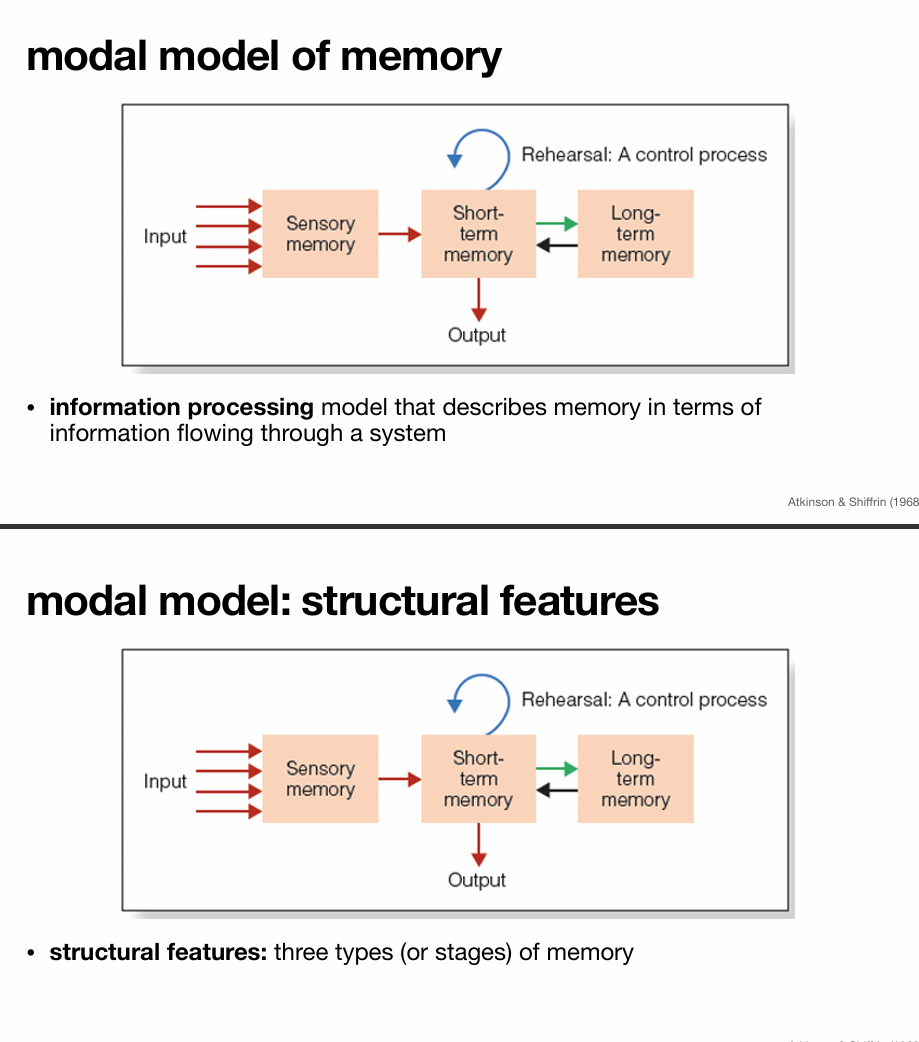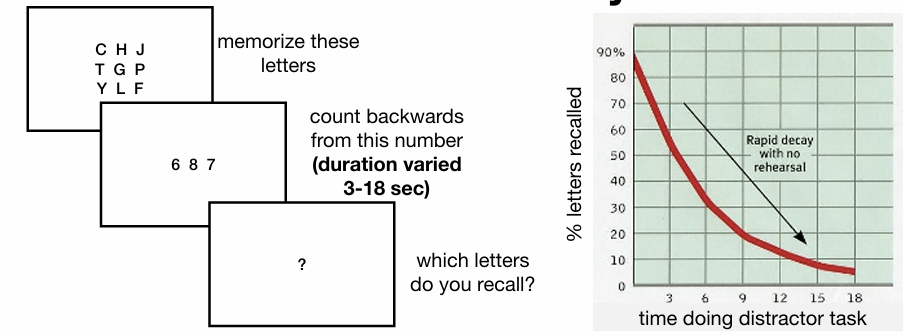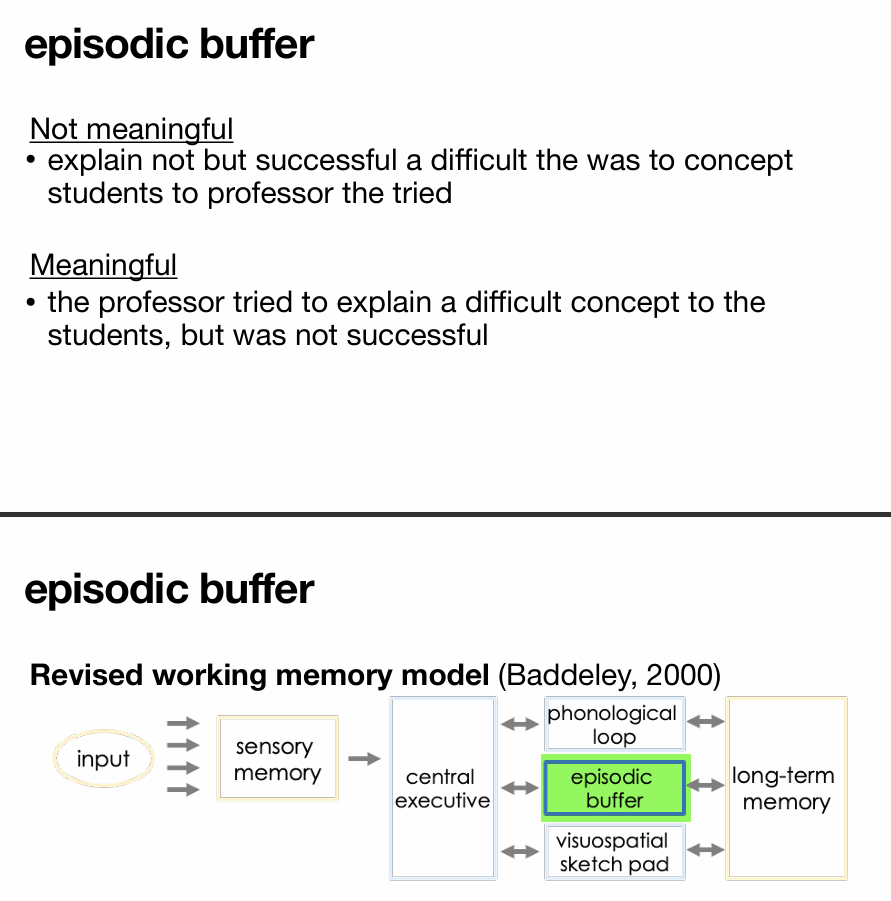Cognitive exam 2 STM, Sensory, Working
1/21
There's no tags or description
Looks like no tags are added yet.
Name | Mastery | Learn | Test | Matching | Spaced |
|---|
No study sessions yet.
22 Terms
memory
the processes of retaining, retrieving, and using information about stimuli, images, events, ideas, and skills after the original information is no longer present
Modal model of memory (Atkinson and Shiffrin 1968)
Memory as an information processing system.
The diagram shows how information flows through three stages:
Sensory memory: Briefly holds incoming sensory information.
Short-term memory (STM): Temporarily stores information we are actively thinking about.
Long-term memory (LTM): Stores information more permanently.
Rehearsal (the curved arrow) is a control process that helps transfer information from STM to LTM.
Output represents the information that is retrieved or used from STM.
Purpose: This slide emphasizes the functional flow—how information moves through the system.
Main Idea: Focuses on the three stages or structures of memory.
These stages are:
Sensory memory
Short-term memory
Long-term memory
While the diagram is the same, the emphasis here is on structure, not process.
Purpose: This slide highlights the architecture of the model—what memory is made of rather than how it operates.

Modal model explained: structural features
• sensory memory: input from the senses is held for a few seconds
• short-term memory: holds a limited amount of information for up to 20 seconds
• long-term memory: holds a large amount of information for many years
green= encoding, only attended info
black= retrieval

Modal model explained: control processes
• rehearsal: control processes used to keep information in short-term memory
• memorizing: control processes used to get information from short-term memory into long-term memory
• retrieval: control processes used to get information from long-term memory into short-term memory
ex: Clive Wearing struggles with encoding STM→ LTM
Sensory memory
memory system for holding sensory stimulation for very brief periods of time
typically lasts under a second to a few seconds
so short that sometimes considered part of perception
types:
echoic: auditory
iconic: visual
Iconic memory
memory for visual stimulation that lasts longer than a second
• persistence of vision: continued perception of a visual stimulus after it is no longer present
Sensory Memory Capacity: Whole Report Method
designed to measure the capacity and duration of sensory memory, particularly iconic memory, which is the visual form of sensory memory.
In his classic 1960 experiment, Sperling briefly flashed a grid of 12 letters (3 rows of 4) on a screen for just 50 milliseconds. Participants were then asked to report as many letters as they could remember—this is the whole report condition.
Key Findings:
On average, participants could only recall about 4–5 letters, even though they reported seeing more.
This suggested that the entire grid of letters was available in sensory memory, but the information faded too quickly (within less than a second) for participants to report it all before it decayed.
Therefore, sensory memory has a high capacity, but very limited duration.
we briefly take in much more visual information than we can report, because sensory memory holds information momentarily and decays rapidly unless attention is directed to it or it's transferred to short-term memory.

Sensory Memory Capacity: Partial Report Method
used the same 12-letter grid (3 rows of 4 letters shown for 50 milliseconds), but instead of asking participants to report all the letters, he presented a tone immediately after the display:
High tone = report the top row
Medium tone = report the middle row
Low tone = report the bottom row
Because the tone came after the letters disappeared, participants didn’t know in advance which row to focus on—meaning they had to temporarily store the entire grid in sensory memory.
Key Findings:
Participants could recall almost all the letters from the cued row—usually about 3 out of 4 letters.
Since the row was randomly selected after the stimulus disappeared, this meant the entire display was initially available in memory.
Conclusion:
sensory memory has a very large capacity, holding most or all of the visual scene briefly. However, unless attention is directed to specific parts of it (like through the tone cue), that information quickly fades—within about 1 second.
Whole report vs. Partial report
Task:
Whole report = recall all letters
Partial report = recall one cued row
Recall Performance:
Whole = ~4–5 letters total
Partial = ~3–4 letters from any row
Memory Insight:
Whole = suggests rapid decay limits recall
Partial = reveals high initial capacity
Conclusion:
Whole = sensory memory seems limited
Partial = sensory memory is large but brief
The whole report reveals that sensory memory has a brief duration and limited observable capacity, while the partial report shows it actually has a larger capacity but very short duration before information fades.
short-term memory (STM)
memory system for storing small amounts of information for a brief period of time
holds 5-9 items for up to 15-20 seconds
STM includes new information from sensory memory, current information being rehearsed in STM (“working memory”), and old information retrieved from LTM
Duration of STM: Brown-Peterson task:
How the Task Works:
Participants are shown a 3-letter consonant trigram (e.g., "KLP").
Immediately after, they are asked to count backward by threes from a given number (e.g., 742) for a few seconds (to prevent rehearsal).
After a delay (3–18 seconds), they're asked to recall the trigram.
Key Findings:
Recall drops sharply as the delay increases.
At 3 seconds: ~80% recall
At 18 seconds: ~10% recall
This shows that without rehearsal, information in STM fades quickly—typically within 15–20 seconds.
shows that STM has a short duration—only a few seconds—unless we actively rehearse the information to keep it active or move it into long-term memory.

Capacity of STM: Digit span task and chunking
Participants hear or see a series of random digits (e.g., 7-1-4-9-2) and must repeat them back in order.
The number of digits increases until the participant can no longer recall them correctly.
Key Findings:
Most people can recall about 7 ± 2 digits (i.e., between 5 and 9)—this is known as Miller’s "magic number".
This reflects the limited capacity of STM.
ALTERNATIVE:
Chunking: combine smaller units of digits in larger (818-963-2192)
• i.e., chunking does not change capacity limits, but you can get in more “items” when the Ericsson, Chase, et al., (1980) information is chunked

Capacity of STM: Change Detection task
Participants are shown an array of items (e.g., shapes or colors) for a brief period. After a short delay, a second array is presented, and participants must identify whether a change occurred.
Key Findings:
The typical capacity of STM is 7±2 items (Miller’s Law).
Performance declines as the number of items in the array increases beyond this capacity.
The Change Detection task shows that STM has a limited capacity, typically 7 items. The ability to detect changes drops when the array exceeds this limit, unless cognitive strategies (e.g., chunking) are used.
working memory
memory system for storing and manipulating small amounts of information for a brief period of time
ex:
understanding speech requires storing and manipulating small amounts of information for a brief period of time
Calculations require storing and manipulating small amounts of information for a brief period of time
manipulations require storing and manipulating small amounts of information for a brief period of time (spell word backwards)
following directions requires storing and manipulating small amounts of information for a brief period of time
solving problems requires storing and manipulating small amounts of information for a brief period of time
WM: Digit span forward and backward
• digit span forward task: repeat a string of digits; the number of digits increases on each trial
• digit span backward task: repeat a string of digits backward; the number of digits increases on each trial
Modal Model of WORKING memory: Baddeley
Central executive: controls attention and coordinates the phonological loop and visuospatial sketchpad. It manages tasks like switching attention, inhibiting distractions, and supporting higher cognitive functions like problem-solving.
phonological loop: holds verbal and auditory information
visuospatial sketch pad: holds visual and spatial information

Phonological loop
holds verbal and auditory information
• phonological store: holds a limited amount of verbal and auditory information for a few seconds
ex: when you hear a phone number, like (555) 123-4567, and repeat it to yourself to remember it long enough to dial. Holds the verbal information temporarily before it's either forgotten or transferred to long-term memory.
• articulatory rehearsal process: (1) actively maintains information and (2) translates visual information into verbal form.
ex: when trying to remember a phone number like (555) 123-4567, you might silently repeat it over and over to yourself as you prepare to dial it. This process helps maintain the information in memory for a longer period.
Evidence for phonological loop
phonological similarity effect: letters or words that sound similar are confused
word length effect: memory is better for shorter than for longer words
articulatory suppression: memory is worse when speaking interferes with rehearsal
Visuospatial sketch pad
holds visual and spatial information
• visual imagery: creating visual images in the mind in the absence of visual input
• mental rotation: rotating visual images in the mind
central executive
coordinates the information in the phonological loop and visuospatial sketch pad to direct attention
• perseveration: repeatedly perform the same action or thought
ex: The Wisconsin Card Sorting Test (WCST) assesses the central executive by having participants sort cards based on changing rules. The central executive manages task switching, attention, and inhibition of old rules to adapt to the new ones, testing cognitive flexibility and problem-solving.
Working memory ex
What is each component doing when you talk on the phone while driving?
• phonological loop: following the phone conversation
• visuospatial sketch pad: tracking cars, people, and roads; navigating the route
• central executive: directing attention between the tasks
Revised WM model (Baddeley)
• episodic buffer: integrates information across modalities (visual, verbal) to form units
EX: Imagine you watch a short video where a person says, “Let’s go to the beach,” while standing in front of the ocean.
The phonological loop handles the words you hear.
The visuospatial sketchpad processes the image of the beach.
The episodic buffer combines the sound and image into a single, meaningful episode you can later recall as a whole.
